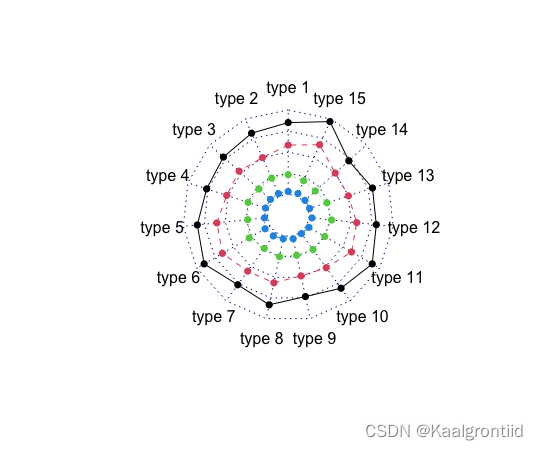鉴定一下网络热门函数。
这次分析的函数是fmsb包中的radarchart()函数,用途是生成雷达图。
预期结果大约是这样:

原函数内部结构在这里:
radarchart <- function(df, axistype=0, seg=4, pty=16, pcol=1:8, plty=1:6, plwd=1,
pdensity=NULL, pangle=45, pfcol=NA, cglty=3, cglwd=1,
cglcol="navy", axislabcol="blue", title="", maxmin=TRUE,
na.itp=TRUE, centerzero=FALSE, vlabels=NULL, vlcex=NULL,
caxislabels=NULL, calcex=NULL,
paxislabels=NULL, palcex=NULL, ...) {
if (!is.data.frame(df)) { cat("The data must be given as dataframe.\n"); return() }
if ((n <- length(df))<3) { cat("The number of variables must be 3 or more.\n"); return() }
if (maxmin==FALSE) { # when the dataframe does not include max and min as the top 2 rows.
dfmax <- apply(df, 2, max)
dfmin <- apply(df, 2, min)
df <- rbind(dfmax, dfmin, df)
}
plot(c(-1.2, 1.2), c(-1.2, 1.2), type="n", frame.plot=FALSE, axes=FALSE,
xlab="", ylab="", main=title, asp=1, ...) # define x-y coordinates without any plot
theta <- seq(90, 450, length=n+1)*pi/180
theta <- theta[1:n]
xx <- cos(theta)
yy <- sin(theta)
CGap <- ifelse(centerzero, 0, 1)
for (i in 0:seg) { # complementary guide lines, dotted navy line by default
polygon(xx*(i+CGap)/(seg+CGap), yy*(i+CGap)/(seg+CGap), lty=cglty, lwd=cglwd, border=cglcol)
if (axistype==1|axistype==3) CAXISLABELS <- paste(i/seg*100,"(%)")
if (axistype==4|axistype==5) CAXISLABELS <- sprintf("%3.2f",i/seg)
if (!is.null(caxislabels)&(i<length(caxislabels))) CAXISLABELS <- caxislabels[i+1]
if (axistype==1|axistype==3|axistype==4|axistype==5) {
if (is.null(calcex)) text(-0.05, (i+CGap)/(seg+CGap), CAXISLABELS, col=axislabcol) else
text(-0.05, (i+CGap)/(seg+CGap), CAXISLABELS, col=axislabcol, cex=calcex)
}
}
if (centerzero) {
arrows(0, 0, xx*1, yy*1, lwd=cglwd, lty=cglty, length=0, col=cglcol)
}
else {
arrows(xx/(seg+CGap), yy/(seg+CGap), xx*1, yy*1, lwd=cglwd, lty=cglty, length=0, col=cglcol)
}
PAXISLABELS <- df[1,1:n]
if (!is.null(paxislabels)) PAXISLABELS <- paxislabels
if (axistype==2|axistype==3|axistype==5) {
if (is.null(palcex)) text(xx[1:n], yy[1:n], PAXISLABELS, col=axislabcol) else
text(xx[1:n], yy[1:n], PAXISLABELS, col=axislabcol, cex=palcex)
}
VLABELS <- colnames(df)
if (!is.null(vlabels)) VLABELS <- vlabels
if (is.null(vlcex)) text(xx*1.2, yy*1.2, VLABELS) else
text(xx*1.2, yy*1.2, VLABELS, cex=vlcex)
series <- length(df[[1]])
SX <- series-2
if (length(pty) < SX) { ptys <- rep(pty, SX) } else { ptys <- pty }
if (length(pcol) < SX) { pcols <- rep(pcol, SX) } else { pcols <- pcol }
if (length(plty) < SX) { pltys <- rep(plty, SX) } else { pltys <- plty }
if (length(plwd) < SX) { 







 本文详细分析了R语言fmsb包中的radarchart函数,用于生成雷达图。讨论了函数处理数据的要求,包括数据格式、最小对象数,以及maxmin参数的影响。此外,还解释了centerzero参数如何改变图形中心,axistype参数的不同样式,以及如何自定义轴标签。最后,介绍了函数如何处理缺失值并生成最终的雷达图。
本文详细分析了R语言fmsb包中的radarchart函数,用于生成雷达图。讨论了函数处理数据的要求,包括数据格式、最小对象数,以及maxmin参数的影响。此外,还解释了centerzero参数如何改变图形中心,axistype参数的不同样式,以及如何自定义轴标签。最后,介绍了函数如何处理缺失值并生成最终的雷达图。
 最低0.47元/天 解锁文章
最低0.47元/天 解锁文章
















 1422
1422

 被折叠的 条评论
为什么被折叠?
被折叠的 条评论
为什么被折叠?








